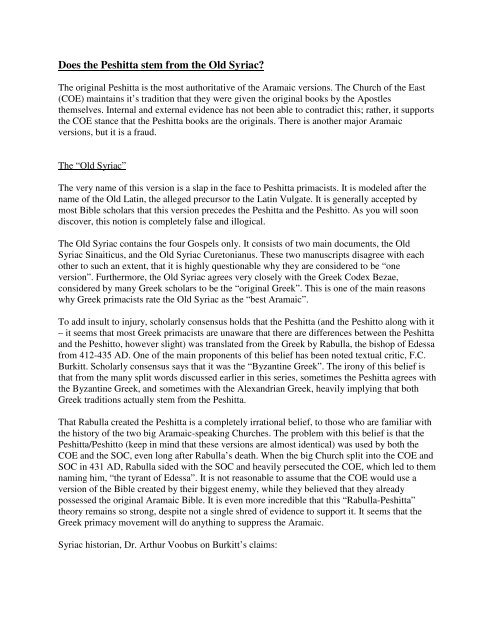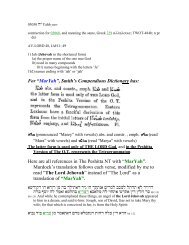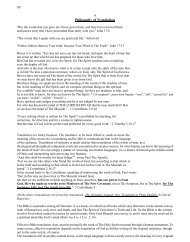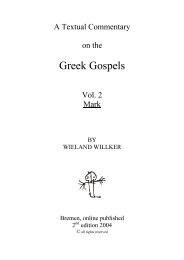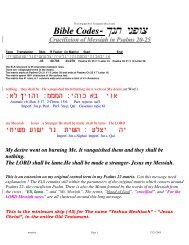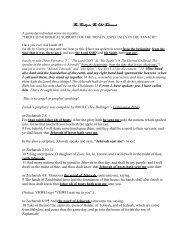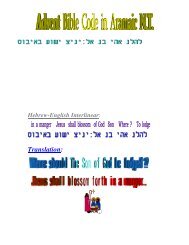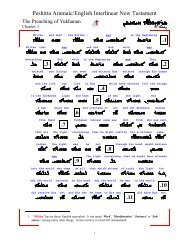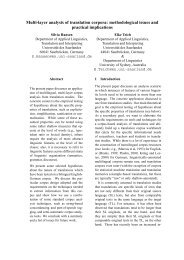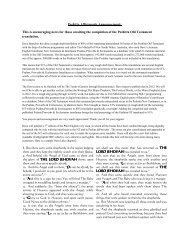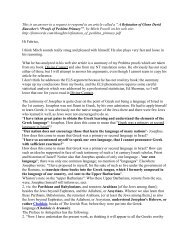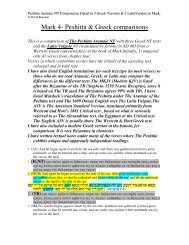Does the Peshitta stem from the Old Syriac? - Aramaic New Testament
Does the Peshitta stem from the Old Syriac? - Aramaic New Testament
Does the Peshitta stem from the Old Syriac? - Aramaic New Testament
You also want an ePaper? Increase the reach of your titles
YUMPU automatically turns print PDFs into web optimized ePapers that Google loves.
<strong>Does</strong> <strong>the</strong> <strong>Peshitta</strong> <strong>stem</strong> <strong>from</strong> <strong>the</strong> <strong>Old</strong> <strong>Syriac</strong>?<br />
The original <strong>Peshitta</strong> is <strong>the</strong> most authoritative of <strong>the</strong> <strong>Aramaic</strong> versions. The Church of <strong>the</strong> East<br />
(COE) maintains it’s tradition that <strong>the</strong>y were given <strong>the</strong> original books by <strong>the</strong> Apostles<br />
<strong>the</strong>mselves. Internal and external evidence has not been able to contradict this; ra<strong>the</strong>r, it supports<br />
<strong>the</strong> COE stance that <strong>the</strong> <strong>Peshitta</strong> books are <strong>the</strong> originals. There is ano<strong>the</strong>r major <strong>Aramaic</strong><br />
versions, but it is a fraud.<br />
The “<strong>Old</strong> <strong>Syriac</strong>”<br />
The very name of this version is a slap in <strong>the</strong> face to <strong>Peshitta</strong> primacists. It is modeled after <strong>the</strong><br />
name of <strong>the</strong> <strong>Old</strong> Latin, <strong>the</strong> alleged precursor to <strong>the</strong> Latin Vulgate. It is generally accepted by<br />
most Bible scholars that this version precedes <strong>the</strong> <strong>Peshitta</strong> and <strong>the</strong> Peshitto. As you will soon<br />
discover, this notion is completely false and illogical.<br />
The <strong>Old</strong> <strong>Syriac</strong> contains <strong>the</strong> four Gospels only. It consists of two main documents, <strong>the</strong> <strong>Old</strong><br />
<strong>Syriac</strong> Sinaiticus, and <strong>the</strong> <strong>Old</strong> <strong>Syriac</strong> Curetonianus. These two manuscripts disagree with each<br />
o<strong>the</strong>r to such an extent, that it is highly questionable why <strong>the</strong>y are considered to be “one<br />
version”. Fur<strong>the</strong>rmore, <strong>the</strong> <strong>Old</strong> <strong>Syriac</strong> agrees very closely with <strong>the</strong> Greek Codex Bezae,<br />
considered by many Greek scholars to be <strong>the</strong> “original Greek”. This is one of <strong>the</strong> main reasons<br />
why Greek primacists rate <strong>the</strong> <strong>Old</strong> <strong>Syriac</strong> as <strong>the</strong> “best <strong>Aramaic</strong>”.<br />
To add insult to injury, scholarly consensus holds that <strong>the</strong> <strong>Peshitta</strong> (and <strong>the</strong> Peshitto along with it<br />
– it seems that most Greek primacists are unaware that <strong>the</strong>re are differences between <strong>the</strong> <strong>Peshitta</strong><br />
and <strong>the</strong> Peshitto, however slight) was translated <strong>from</strong> <strong>the</strong> Greek by Rabulla, <strong>the</strong> bishop of Edessa<br />
<strong>from</strong> 412-435 AD. One of <strong>the</strong> main proponents of this belief has been noted textual critic, F.C.<br />
Burkitt. Scholarly consensus says that it was <strong>the</strong> “Byzantine Greek”. The irony of this belief is<br />
that <strong>from</strong> <strong>the</strong> many split words discussed earlier in this series, sometimes <strong>the</strong> <strong>Peshitta</strong> agrees with<br />
<strong>the</strong> Byzantine Greek, and sometimes with <strong>the</strong> Alexandrian Greek, heavily implying that both<br />
Greek traditions actually <strong>stem</strong> <strong>from</strong> <strong>the</strong> <strong>Peshitta</strong>.<br />
That Rabulla created <strong>the</strong> <strong>Peshitta</strong> is a completely irrational belief, to those who are familiar with<br />
<strong>the</strong> history of <strong>the</strong> two big <strong>Aramaic</strong>-speaking Churches. The problem with this belief is that <strong>the</strong><br />
<strong>Peshitta</strong>/Peshitto (keep in mind that <strong>the</strong>se versions are almost identical) was used by both <strong>the</strong><br />
COE and <strong>the</strong> SOC, even long after Rabulla’s death. When <strong>the</strong> big Church split into <strong>the</strong> COE and<br />
SOC in 431 AD, Rabulla sided with <strong>the</strong> SOC and heavily persecuted <strong>the</strong> COE, which led to <strong>the</strong>m<br />
naming him, “<strong>the</strong> tyrant of Edessa”. It is not reasonable to assume that <strong>the</strong> COE would use a<br />
version of <strong>the</strong> Bible created by <strong>the</strong>ir biggest enemy, while <strong>the</strong>y believed that <strong>the</strong>y already<br />
possessed <strong>the</strong> original <strong>Aramaic</strong> Bible. It is even more incredible that this “Rabulla-<strong>Peshitta</strong>”<br />
<strong>the</strong>ory remains so strong, despite not a single shred of evidence to support it. It seems that <strong>the</strong><br />
Greek primacy movement will do anything to suppress <strong>the</strong> <strong>Aramaic</strong>.<br />
<strong>Syriac</strong> historian, Dr. Arthur Voobus on Burkitt’s claims:
“This kind of reconstruction of textual history is pure fiction without a shred of evidence to<br />
support it” – Early Versions of <strong>the</strong> <strong>New</strong> <strong>Testament</strong>, Estonian Theological Society, 1954, pp. 90-<br />
97<br />
Famous textual critic, Dr. Bruce Metzger adds:<br />
“The question who it was that produced <strong>the</strong> <strong>Peshitta</strong> version of <strong>the</strong> <strong>New</strong> <strong>Testament</strong> will perhaps<br />
never be answered. That it was not Rubbula has been proved by Voobus's researches. . .In any<br />
case, however, in view of <strong>the</strong> adoption of <strong>the</strong> same version of <strong>the</strong> Scriptures by both <strong>the</strong> Eastern<br />
(Nestorian) and Western (Jacobite) branches of Syrian Christendom, we must conclude that it<br />
had attained a considerable degree of status before <strong>the</strong> division of <strong>the</strong> Syrian Church in AD<br />
431.” – Early Versions of <strong>the</strong> <strong>New</strong> <strong>Testament</strong>, <strong>New</strong> York: Claredon, 1977, p. 36<br />
Burkitt’s <strong>the</strong>ory is all <strong>the</strong> more illogical when you consider that <strong>the</strong> COE and SOC were<br />
practically mortal enemies, yet were using <strong>the</strong> same <strong>Aramaic</strong> tradition. Clearly, <strong>the</strong> <strong>Peshitta</strong> must<br />
have gained much respect and reverence by <strong>the</strong> COE and SOC, long before <strong>the</strong>y split.<br />
Now that we have cast aside <strong>the</strong> notion that Rabulla created <strong>the</strong> <strong>Peshitta</strong> <strong>from</strong> <strong>the</strong> Greek<br />
translation, we yet do not cast aside <strong>the</strong> idea that Rabulla did in fact make an <strong>Aramaic</strong> version<br />
form <strong>the</strong> Greek. A colleague of his wrote <strong>the</strong> following after Rabulla’s death:<br />
“By <strong>the</strong> wisdom of God that was in him he translated <strong>the</strong> <strong>New</strong> <strong>Testament</strong> <strong>from</strong> Greek into<br />
<strong>Syriac</strong> because of its variations, exactly as it was.” – Rabul episcopi Edesseni, Baleei,<br />
aliorumque opera selecta, Oxford 1865, ed. J. J. Overbeck<br />
Rabulla himself stated:<br />
“The presbyters and deacons shall see to it that in all <strong>the</strong> churches a copy of <strong>the</strong> Evangelion de<br />
Mepharreshe shall be available and read.” – . Zahn, Forschungen zur Geschichte des<br />
neutestamentlichen Kanons, i. (1881), p. 105<br />
Clearly, Rabulla did make an <strong>Aramaic</strong> version using <strong>the</strong> Greek. And we have its name:<br />
Evangelion de Mepharreshe.<br />
Could this be <strong>the</strong> <strong>Old</strong> <strong>Syriac</strong>? We shall let <strong>the</strong> <strong>Old</strong> <strong>Syriac</strong> itself answer that one!<br />
The header to OS Mat<strong>the</strong>w reads: “Evangelion de Mepharreshe”.
<strong>Old</strong> <strong>Syriac</strong> John (<strong>the</strong> last of <strong>the</strong> four Gospels) ends with:<br />
04rpmd Jwylgnw0 Ml4<br />
“Shlam Evangelion de Mepharreshe”<br />
“Here ends <strong>the</strong> Evangelion de Mepharreshe”
Clearly, Rabulla’s version was <strong>the</strong> <strong>Old</strong> <strong>Syriac</strong>, not <strong>the</strong> <strong>Peshitta</strong>. Besides this blatant proof, <strong>the</strong><br />
“Evangelion de Mepharreshe” has little in common with <strong>the</strong> <strong>Peshitta</strong>, even though <strong>the</strong>y are<br />
apparently “<strong>the</strong> same version”.<br />
This title, “Evangelion de Mepharreshe” is a combination of Greek and <strong>Aramaic</strong>, meaning<br />
“Separate Gospels”. This brings us to a discussion on a minor <strong>Aramaic</strong> version that has played<br />
such a major role in <strong>the</strong> history of <strong>the</strong> misunderstandings of <strong>the</strong> original <strong>Aramaic</strong> Scriptures. This<br />
minor version will also help to explain why Rabulla made his own version of <strong>the</strong> Gospels in <strong>the</strong><br />
first place.
Rabulla, <strong>the</strong> <strong>Old</strong> <strong>Syriac</strong> and Tatian’s Diatessaron<br />
Infamous Assyrian apologist, Tatian, created a harmony of <strong>the</strong> four <strong>Peshitta</strong> Gospels, in order to<br />
have a continuous narrative of <strong>the</strong> life of Jesus. This <strong>Aramaic</strong> version is known as <strong>the</strong><br />
“Diatessaron” (meaning “Gospel harmony”) aka “Evangelion da Mehallete”. Sound familiar? It<br />
should. It basically means, “Mixed Gospels”. It is generally accepted by most scholars as being<br />
published around 175 AD or earlier. Only fragments remain of <strong>the</strong> original <strong>Aramaic</strong> version, but<br />
fur<strong>the</strong>r translations into Arabic, Latin and Armenian still exist.<br />
The Diatessaron became a very popular version in Syria, during <strong>the</strong> 4 th and 5 th centuries. Even in<br />
Edessa, <strong>the</strong> diocese of Rabulla. When he saw that nearly every Church was using <strong>the</strong><br />
Diatessaron, Rabulla ordered <strong>the</strong> priests and deacons to ensure that every church should have a<br />
copy of <strong>the</strong> his “Evangelion da Mepharreshe”.<br />
He wanted to replace <strong>the</strong> “Evangelion da Mehallete” (“Mixed Gospels”) with his “Evangelion da<br />
Mepharreshe” (“Separate Gospels”).<br />
The true story now becomes very clear. Rabulla created <strong>the</strong> <strong>Old</strong> <strong>Syriac</strong>, not <strong>the</strong> <strong>Peshitta</strong>! This<br />
makes complete sense, after seeing Rabulla’s emphasis on <strong>the</strong> Gospels (to rival <strong>the</strong> Diatessaron,<br />
<strong>the</strong> harmonised Gospel) and <strong>the</strong> fact that <strong>the</strong> <strong>Old</strong> <strong>Syriac</strong> consists of <strong>the</strong> four Gospels only.<br />
Happily enough, internal evidence <strong>from</strong> <strong>the</strong> Arabic translation of <strong>the</strong> Assyrian Diatessaron (<strong>the</strong><br />
only surviving version translated into a sister Semitic tongue) heavily indicates that <strong>the</strong><br />
Diatessaron <strong>stem</strong>s <strong>from</strong> <strong>the</strong> <strong>Peshitta</strong>. This would date <strong>the</strong> <strong>Peshitta</strong> to around 175 AD at <strong>the</strong><br />
absolute latest. That’s pretty impressive, considering that <strong>the</strong> <strong>New</strong> <strong>Testament</strong> is believed to have<br />
been completed around 100 AD.<br />
But why in countering <strong>the</strong> Diatessaron, did Rabulla create <strong>the</strong> <strong>Old</strong> <strong>Syriac</strong> (<strong>from</strong> <strong>the</strong> Greek<br />
translation), instead of using <strong>the</strong> original <strong>Peshitta</strong> Gospels? The author does not understand,<br />
especially since his ally, <strong>the</strong> SOC, revered <strong>the</strong> <strong>Peshitta</strong> tradition. Perhaps he wanted to make a<br />
name for himself. Or perhaps he conspired to suppress <strong>the</strong> <strong>Peshitta</strong> tradition. Indeed, <strong>the</strong> SOC did<br />
make use of his <strong>Old</strong> <strong>Syriac</strong> for a while, before reverting back to <strong>the</strong>ir more trustworthy Peshitto.<br />
In any case, this investigation yields some vital facts:<br />
• Rabulla did not create <strong>the</strong> <strong>Peshitta</strong>, he created <strong>the</strong> <strong>Old</strong> <strong>Syriac</strong>.<br />
• The <strong>Peshitta</strong> does not <strong>stem</strong> <strong>from</strong> <strong>the</strong> <strong>Old</strong> <strong>Syriac</strong>, <strong>the</strong> <strong>Old</strong> <strong>Syriac</strong> <strong>stem</strong>s <strong>from</strong> <strong>the</strong> <strong>Peshitta</strong>, via <strong>the</strong><br />
Greek.<br />
• The <strong>Peshitta</strong> dates back to 175 AD at <strong>the</strong> very latest.<br />
It all makes sense now. One would expect <strong>the</strong> COE to reject <strong>the</strong> version created by Rabulla, <strong>the</strong>ir<br />
great persecutor. Yet <strong>the</strong>y didn’t reject <strong>the</strong> <strong>Peshitta</strong>. They rejected <strong>the</strong> <strong>Old</strong> <strong>Syriac</strong>. That <strong>the</strong> <strong>Old</strong><br />
<strong>Syriac</strong> was a poor version (unavoidable seeing as it was an <strong>Aramaic</strong> translation <strong>from</strong> a Greek<br />
translation of <strong>the</strong> original <strong>Aramaic</strong>*), is evident not only by <strong>the</strong> COE’s rejection, but also <strong>the</strong>
eventual rejection by <strong>the</strong> SOC, Rabulla’s ally. Both Churches decided to stay with <strong>the</strong> <strong>Peshitta</strong><br />
tradition. Yet scholars still are adamant that <strong>the</strong> <strong>Old</strong> <strong>Syriac</strong> is somehow older and superior to <strong>the</strong><br />
<strong>Peshitta</strong> and Peshitto.<br />
* - The <strong>Old</strong> <strong>Syriac</strong> shares many similarities with <strong>the</strong> Western Greek text (aka Codex Bezae, aka<br />
Manuscript D) as textual critic Dr. James Trimm demonstrates. And <strong>the</strong> Western Greek text<br />
seems to be an early Greek translation of <strong>the</strong> <strong>Peshitta</strong> as indicated by its “Semiticness” (<strong>the</strong> NT<br />
author’s were all Semites after all) and its variants with o<strong>the</strong>r Greek manuscripts, which <strong>stem</strong><br />
<strong>from</strong> mistranslations/misunderstandings of <strong>the</strong> original <strong>Peshitta</strong> passages (split words).<br />
After learning <strong>the</strong> true history of <strong>the</strong> “<strong>Old</strong> <strong>Syriac</strong>”, you may loa<strong>the</strong> to call it by that name. A<br />
popular alternative among <strong>Peshitta</strong> enthusiasts is “<strong>Old</strong> Scratch”, as manuscripts were found<br />
where <strong>the</strong> <strong>Old</strong> <strong>Syriac</strong> was scratched off to make way for a priest’s biography. No Semite would<br />
dare do this to <strong>the</strong> <strong>Peshitta</strong>!<br />
Note: More articles regarding <strong>the</strong> history of <strong>the</strong> <strong>Peshitta</strong> and OS comparisons can be found in my<br />
book.


